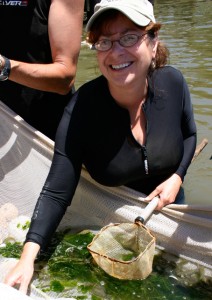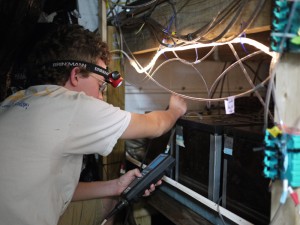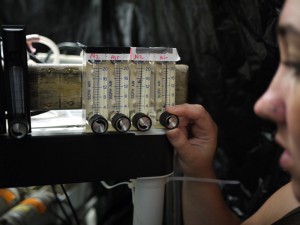
SERC senior scientist Denise Breitburg will lead the NOAA-funded study of hypoxia and acidification in the Chesapeake Bay.
Marine ecologist Denise Breitburg and her colleagues have thought up many novel ways to investigate the impacts of dead zones and acidification on Chesapeake Bay fish and invertebrates. Among their ideas: attaching tiny transmitters to fish and monitoring their movement in relation to oxygen and pH levels. A new $1.4 million grant from the National Oceanic and Atmospheric Administration will enable them to pursue this experiment and a host of others.
Researchers have long known that most fish cannot survive the dead zones that plague the main stem of the Chesapeake Bay. Much less is known about how fluctuations in oxygen levels that occur daily in waters along the Bay’s shoreline affect fish and invertebrates. It is a phenomenon called “diel-cycling hypoxia.” This is where Breitburg and her colleagues from the University of Delaware, Louisiana State University, the NOAA Chesapeake Bay Office and the Maryland Department of Natural Resources will focus their research.
To some extent diel-cycling hypoxia occurs naturally, but nutrients from agriculture, sewage and other human activities exacerbate the problem. Diel-cycling hypoxia happens in shallow waters that are rich with underwater vegetation and phytoplankton. During the daytime, when the plants are photosynthesizing, these areas can become oversaturated with oxygen. However, after the sun sets and organisms continue to respire, oxygen levels plummet and the water becomes hypoxic. Furthermore, respiration adds more CO2 to the water, making it more acidic.

In one experiment, researchers recreate diel-cycling hypoxia in aquaria containing eastern oysters. Breitburg's team is measuring how the nighttime dips in dissolved oxygen impact disease rates in the mollusk.

By adjusting the proportion of air and nitrogen that is pumped into the aquaria, Breitburg's head technician Becca Burrell controls the dissolved oxygen levels that the oysters experience.
Breitburg’s group will begin their lab experiments this fall and fieldwork next summer. The research continues through 2015.
You can read about some of Breitburg’s past research on hypoxia here.


Great Article and worthwhile work.
This is my first comment here so I just wanted to give a quick shout out and say I really enjoy reading through your blog posts.